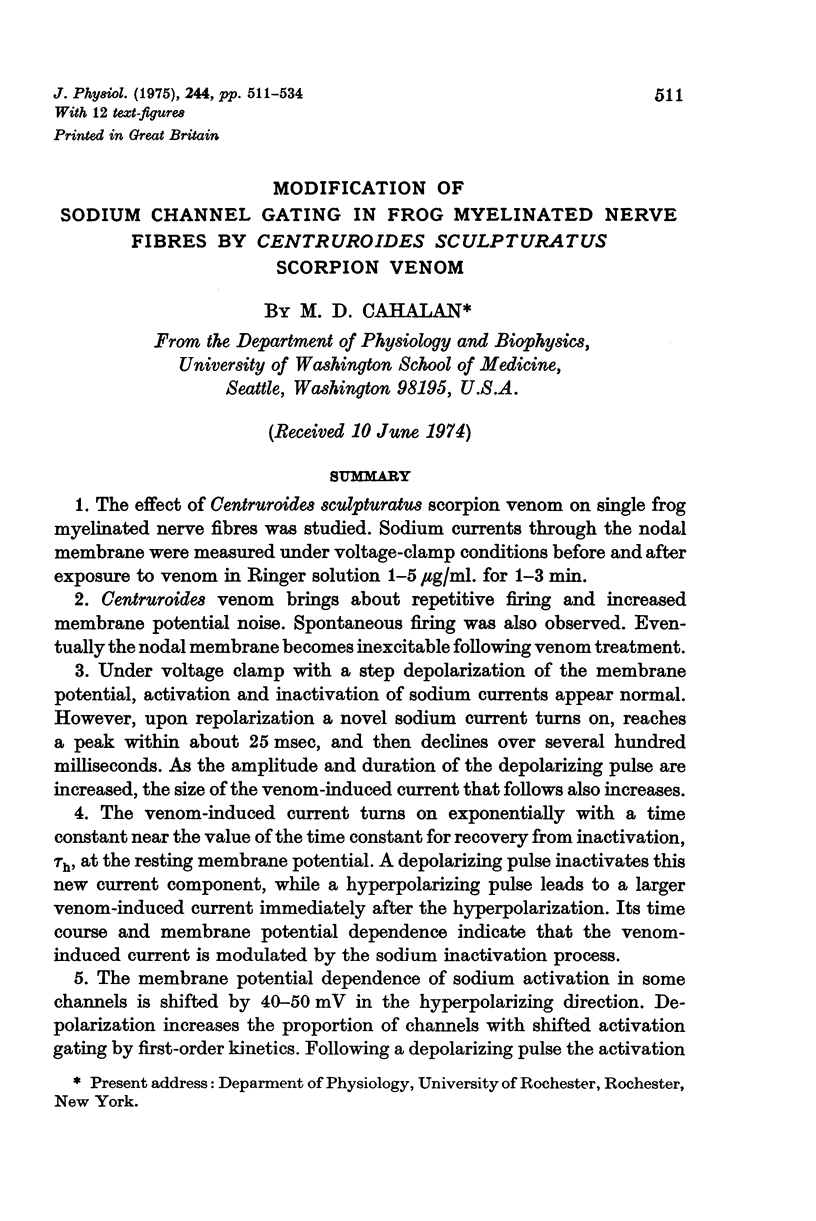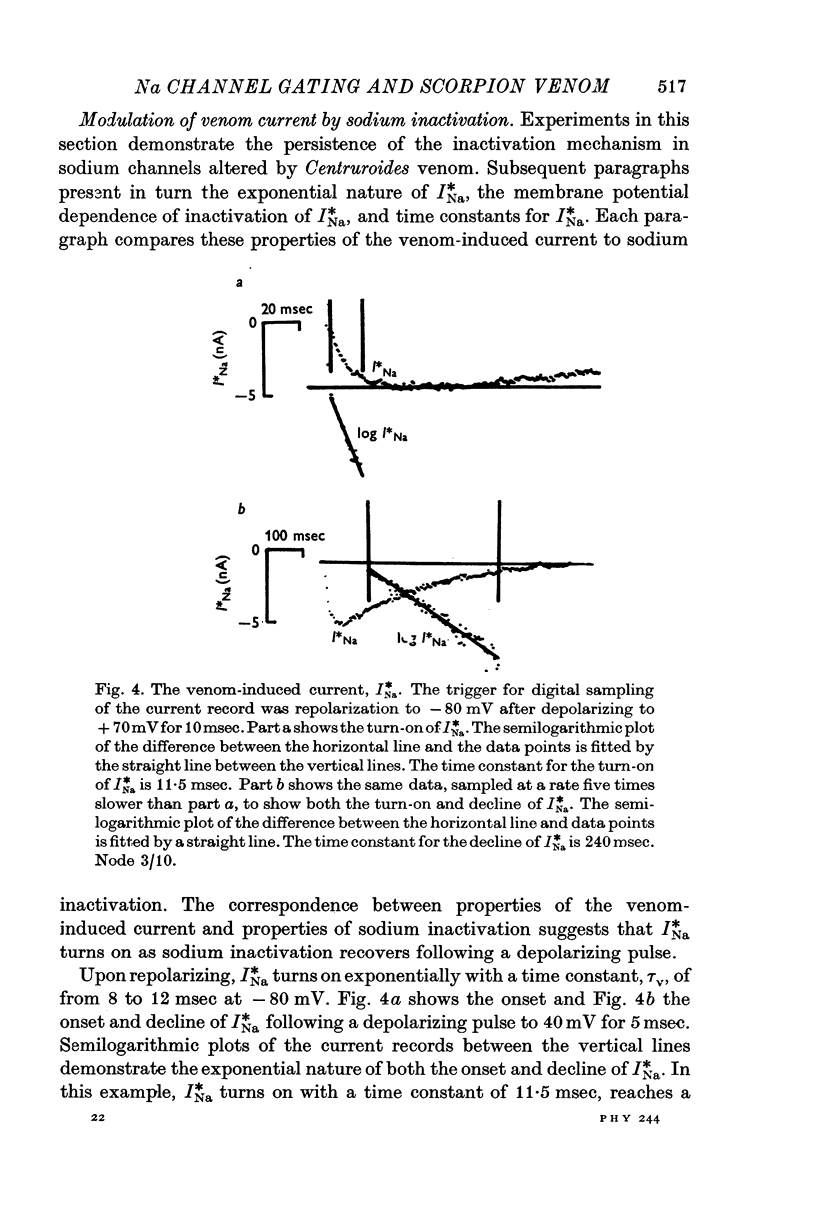Abstract
1. The effect of Centruroides sculpturatus scorpion venom on single frog myelinated nerve fibres was studied. Sodium currents through the nodal membrane were measured under voltage-clamp conditions before and after exposure to venom in Ringer solution 1-5 mug/ml. for 1-3 min. 2. Centruroides venom brings about repetitive firing and increased membrane potential noise. Spontaneous firing was also observed. Eventually the nodal membrane becomes inexcitable following venom treatment. 3. Under voltage clamp with a step depolarization of the membrane potential, activation and inactivation of sodium currents turns on, reaches a peak within about 25 msec, and then declines over several hundred milliseconds. As the amplitude and duration of the depolarizing pulse are increased, the size of the venom-induced current that follows also increases. 4. The venom-induced current turns on exponentially with a time constant near the value of the time constant for recovery from inactivation, tau-h, at the resting membrane potential. A depolarizing pulse inactivates this new current component, while a hyperpolarizing pulse leads to a larger venom-induced current immediately after the hyperpolarization. Its time course and membrane potential dependence indicate that the venom-induced current is modulated by the sodium inactivation process. 5. The membrane potential dependence of sodium activation in some channels is shifted by 40-50 mV in the hyperpolarizing direction. Depolarization increases the proportion of channels with shifted activation gating by first-older kinetics. Following a depolarizing pulse the activation parameter, m-3, remains elevated for hundreds of milliseconds, allowing channels to reopen as recovery from inactivation occurs. 6. A kinetic model with normal inactivation gating and shifted activation gating in some channels accounts for the observed voltage-clamp currents and for the repetitive firing evoked by Centruroides venom. In the model normal channels are converted to channels with shifted activation gating by a voltage dependent reaction. 7. The results suggest limits to possible coupling between sodium channel activation and inactivation. Transitions of the inactivation parameter, h, can occur normally in channels with a shifted membrane potential dependence for activation.
Full text
PDF























Selected References
These references are in PubMed. This may not be the complete list of references from this article.
- Armstrong C. M., Bezanilla F. Currents related to movement of the gating particles of the sodium channels. Nature. 1973 Apr 13;242(5398):459–461. doi: 10.1038/242459a0. [DOI] [PubMed] [Google Scholar]
- Armstrong C. M., Bezanilla F., Rojas E. Destruction of sodium conductance inactivation in squid axons perfused with pronase. J Gen Physiol. 1973 Oct;62(4):375–391. doi: 10.1085/jgp.62.4.375. [DOI] [PMC free article] [PubMed] [Google Scholar]
- Armstrong C. M., Hille B. The inner quaternary ammonium ion receptor in potassium channels of the node of Ranvier. J Gen Physiol. 1972 Apr;59(4):388–400. doi: 10.1085/jgp.59.4.388. [DOI] [PMC free article] [PubMed] [Google Scholar]
- Bezanilla F., Armstrong C. M. Gating currents of the sodium channels: three ways to block them. Science. 1974 Feb 22;183(4126):753–754. doi: 10.1126/science.183.4126.753. [DOI] [PubMed] [Google Scholar]
- Bezanilla F., Armstrong C. M. Negative conductance caused by entry of sodium and cesium ions into the potassium channels of squid axons. J Gen Physiol. 1972 Nov;60(5):588–608. doi: 10.1085/jgp.60.5.588. [DOI] [PMC free article] [PubMed] [Google Scholar]
- DODGE F. A., FRANKENHAEUSER B. Membrane currents in isolated frog nerve fibre under voltage clamp conditions. J Physiol. 1958 Aug 29;143(1):76–90. doi: 10.1113/jphysiol.1958.sp006045. [DOI] [PMC free article] [PubMed] [Google Scholar]
- DODGE F. A., FRANKENHAEUSER B. Sodium currents in the myelinated nerve fibre of Xenopus laevis investigated with the voltage clamp technique. J Physiol. 1959 Oct;148:188–200. doi: 10.1113/jphysiol.1959.sp006281. [DOI] [PMC free article] [PubMed] [Google Scholar]
- Goldman L., Schauf C. L. Inactivation of the sodium current in Myxicola giant axons. Evidence for coupling to the activation process. J Gen Physiol. 1972 Jun;59(6):659–675. doi: 10.1085/jgp.59.6.659. [DOI] [PMC free article] [PubMed] [Google Scholar]
- HODGKIN A. L., HUXLEY A. F. Currents carried by sodium and potassium ions through the membrane of the giant axon of Loligo. J Physiol. 1952 Apr;116(4):449–472. doi: 10.1113/jphysiol.1952.sp004717. [DOI] [PMC free article] [PubMed] [Google Scholar]
- HODGKIN A. L., HUXLEY A. F. The components of membrane conductance in the giant axon of Loligo. J Physiol. 1952 Apr;116(4):473–496. doi: 10.1113/jphysiol.1952.sp004718. [DOI] [PMC free article] [PubMed] [Google Scholar]
- HODGKIN A. L., HUXLEY A. F. The dual effect of membrane potential on sodium conductance in the giant axon of Loligo. J Physiol. 1952 Apr;116(4):497–506. doi: 10.1113/jphysiol.1952.sp004719. [DOI] [PMC free article] [PubMed] [Google Scholar]
- HOYT R. C. THE SQUID GIANT AXON. MATHEMATICAL MODELS. Biophys J. 1963 Sep;3:399–431. doi: 10.1016/s0006-3495(63)86829-0. [DOI] [PMC free article] [PubMed] [Google Scholar]
- Hille B. The permeability of the sodium channel to organic cations in myelinated nerve. J Gen Physiol. 1971 Dec;58(6):599–619. doi: 10.1085/jgp.58.6.599. [DOI] [PMC free article] [PubMed] [Google Scholar]
- Hille B. The selective inhibition of delayed potassium currents in nerve by tetraethylammonium ion. J Gen Physiol. 1967 May;50(5):1287–1302. doi: 10.1085/jgp.50.5.1287. [DOI] [PMC free article] [PubMed] [Google Scholar]
- Keynes R. D., Rojas E. Characteristics of the sodium gating current in the squid giant axon. J Physiol. 1973 Aug;233(1):28P–30P. [PubMed] [Google Scholar]
- Koppenhöfer E., Schmidt H. Die Wirkung von Skorpiongift auf die Ionenströme des Ranvierschen Schnürrings. I. Die Permeabilitäten PNa und PK. Pflugers Arch. 1968;303(2):133–149. doi: 10.1007/BF00592631. [DOI] [PubMed] [Google Scholar]
- Miranda F., Kupeyan C., Rochat H., Rochat C., Lissitzky S. Purification of animal neurotoxins. Isolation and characterization of eleven neurotoxins from the venoms of the scorpions Androctonus australis hector, Buthus occitanus tunetanus and Leiurus quinquestriatus quinquestriatus. Eur J Biochem. 1970 Nov;16(3):514–523. doi: 10.1111/j.1432-1033.1970.tb01111.x. [DOI] [PubMed] [Google Scholar]
- Narahashi T., Moore J. W., Shapiro B. I. Condylactis toxin: interaction with nerve membrane ionic conductances. Science. 1969 Feb 14;163(3868):680–681. doi: 10.1126/science.163.3868.680. [DOI] [PubMed] [Google Scholar]
- Narahashi T., Shapiro B. I., Deguchi T., Scuka M., Wang C. M. Effects of scorpion venom on squid axon membranes. Am J Physiol. 1972 Apr;222(4):850–857. doi: 10.1152/ajplegacy.1972.222.4.850. [DOI] [PubMed] [Google Scholar]
- Peganov E. M., Timin E. N., Khodorov B. I. O vzaimosviazi protsessov natrievoi aktivatsii i inaktivatsii. Biull Eksp Biol Med. 1973 Oct;75(10):7–11. [PubMed] [Google Scholar]
- Pooler J. Photodynamic alteration of sodium currents in lobster axons. J Gen Physiol. 1972 Oct;60(4):367–387. doi: 10.1085/jgp.60.4.367. [DOI] [PMC free article] [PubMed] [Google Scholar]
- Rochat H., Rochat C., Miranda F., Lissitzky S., Edman P. The amino acid sequence of neurotoxin I of Androctonus australis hector. Eur J Biochem. 1970 Dec;17(2):262–266. doi: 10.1111/j.1432-1033.1970.tb01162.x. [DOI] [PubMed] [Google Scholar]
- TASAKI I. New measurements of the capacity and the resistance of the myelin sheath and the nodal membrane of the isolated frog nerve fiber. Am J Physiol. 1955 Jun;181(3):639–650. doi: 10.1152/ajplegacy.1955.181.3.639. [DOI] [PubMed] [Google Scholar]


